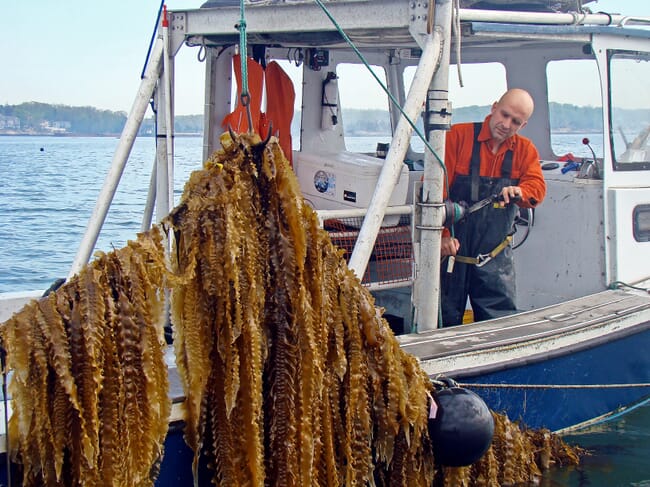
© GreenWave
The project will involve nine states where nascent seaweed aquaculture businesses are being impeded from further growth by the absence of comprehensive financial and management information resources. The economic analysis and business plans created by this project would be intended for use by different types of kelp farms, as well as investors and lenders.
“There has been a real need for the information to be produced by this project to support the development of the kelp industry in Connecticut and the United States,” said project leader Robert Pomeroy, who is professor emeritus at the University of Connecticut and a marine resource economist at Connecticut Sea Grant.
He will work with experts and colleagues in Sea Grant and university extension programmes in New Hampshire, Maine, Rhode Island, Alaska, Washington, California, New York and Massachusetts to develop education and outreach programmes needed for seaweed farmers, investors and lenders to make informed decisions. The grant funds will pay mainly for staff time required to research and analyse information on existing farms and markets, as well as varying regulatory and environmental conditions in different states.
“The anticipated outcomes of this project include more access to capital, more informed business decisions by farmers, investors and lenders, increased employment, greater success of business and environmental improvements,” Pomeroy said in a news release by Judy Benson of Connecticut Sea Grant.
Working as co-investigator on the project will be Tammy Warner, assistant professor of management at Keene State College in New Hampshire. She will lead the business planning aspects.
“I look forward to leveraging my experience in small business and start-up financing to support the development of this exciting new industry,” Warner said. “Fundamentally, business planning for seaweed farmers is the same as for any small business. It’s about communicating your goals and intentions to those who can help them come to fruition.”
According to current estimates, about 1 million pounds of seaweed is currently harvested from US waters, with forecasts that the market could expand to 4 million pounds annually by 2035 if barriers can be overcome.
Kelp, the most common type of cultivated seaweed in the United States, is seen as an important new agriculture product for food, medicinal products, additives and bioremediation of marine pollutants. Internationally, the seaweed market has been expanding rapidly, and more than 95 percent of the seaweed now consumed in the United States is grown overseas. According to current estimates, about 1 million pounds of seaweed is currently harvested from US waters, with forecasts that the market could expand to 4 million pounds annually by 2035 if barriers can be overcome. In Connecticut, there are currently 15 permitted kelp growing sites, with four of those currently under production.
Pomeroy noted that the project builds on another Connecticut Sea Grant-led initiative, the establishment of the National Seaweed Hub in 2019 and first-ever National Seaweed Symposium last March. It brought together 100 farmers, researchers, regulators and others to work together to move the industry forward. Headed by Anoushka Concepcion, Connecticut Sea Grant aquaculture extension specialist, the National Seaweed Hub serves as a clearinghouse to troubleshoot and brainstorm how to overcome obstacles the industry faces.
“This project will address two priorities identified through a comprehensive national needs assessment of various seaweed stakeholders, conducted as part of the National Seaweed Hub’s efforts,” she said. “The first is to better understand the economics of seaweed farming in the United States, and the second is the need for assistance with developing business plans for prospective seaweed farmers.”
One part of the project will quantify the financial value of the ecosystem services performed by kelp farms, which consist of networks of lines anchored in offshore areas. The kelp is seeded onto the lines, growing to harvest size in a few months. After harvest, it is processed into products such as kelp noodles, kelp powder and blanched and frozen to be served as a vegetable. It is considered both a highly nutritious and environmentally friendly crop, offsetting carbon emissions and removing excess nutrients from marine waters as it grows. One goal of the project is to enable farmers to monetize these ecosystem services.
The $766,650 grant is the second largest of 12 awarded by NOAA Sea Grant program to specifically address the economic and market needs of the US aquaculture industry. A total of $4.7 million in was awarded.
“The projects represent Sea Grant’s commitment to not only understanding the science behind sustainable aquaculture in the US but also the economics and market possibilities for sustainable aquaculture,” said National Sea Grant Director Jonathan Pennock. “We think these projects will provide valuable knowledge and new resources to help strengthen and expand the US aquaculture industry.”



